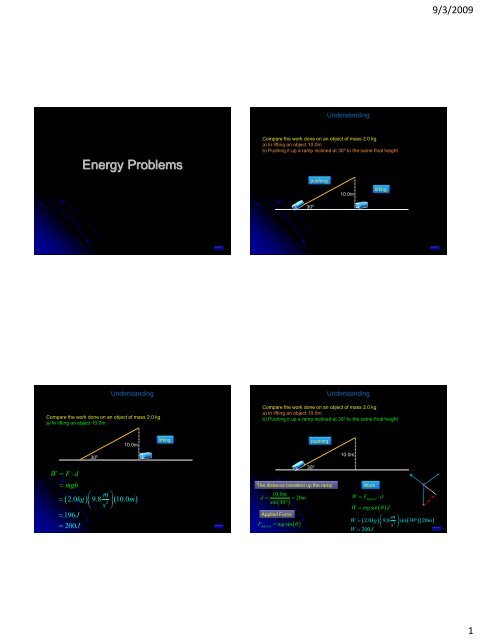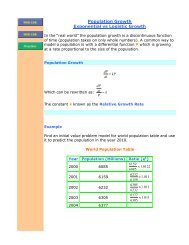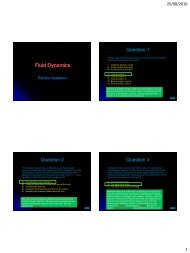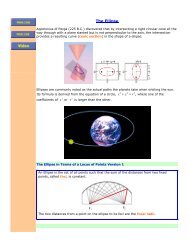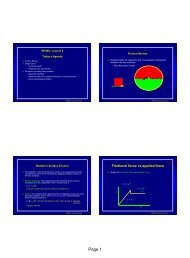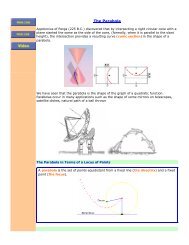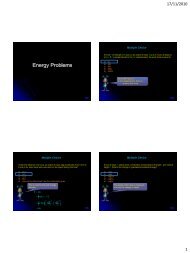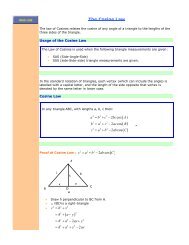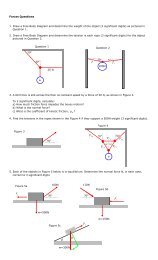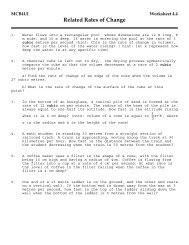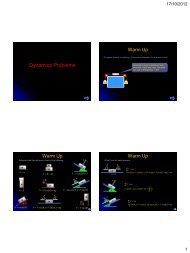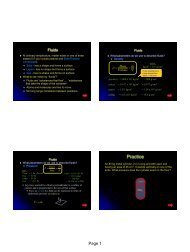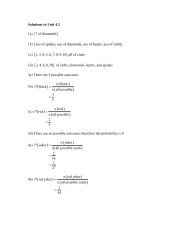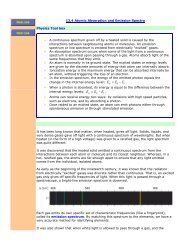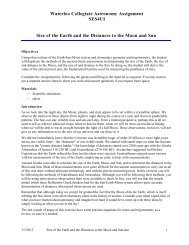Energy Problems - The Burns Home Page
Energy Problems - The Burns Home Page
Energy Problems - The Burns Home Page
- No tags were found...
You also want an ePaper? Increase the reach of your titles
YUMPU automatically turns print PDFs into web optimized ePapers that Google loves.
9/3/2009Question 9A 2000 kg elevator with broken cables is falling at 25 m/s when it firstcontacts a cushioning spring at the bottom of the shaft. <strong>The</strong> spring issupposed to stop the elevator, compressing 3.00 m as it does. Duringthe motion a safety clamp applies a constant 17,000 N frictional force tothe elevator.a) Determine the force constant of the spring.Solution to Question 9A 2000 kg elevator with broken cables is falling at 25 m/s when it first contacts a cushioningspring at the bottom of the shaft. <strong>The</strong> spring is supposed to stop the elevator, compressing3.00 m as it does. During the motion a safety clamp applies a constant 17,000 N frictionalforce to the elevator.a) Determine the force constant of the spring.<strong>The</strong> elevator’s initial kinetic energy is:1 2 1 m K1 mv1 2000 kg 25 625,000 J2 2 s If we use Point 1 to be the origin, then wehave U s =0 and U grav =0, and so U 1 =0At Point 2, there is both gravitational andelastic potential energy, but no kineticenergy21 2U2 mgy2 ky Putting the conservation of energy to work:22K 1 +U 1 +W other =K 2 +U 2Solution to Question 9A 2000 kg elevator with broken cables is falling at 25 m/s when it first contacts a cushioningspring at the bottom of the shaft. <strong>The</strong> spring is supposed to stop the elevator, compressing3.00 m as it does. During the motion a safety clamp applies a constant 17,000 N frictionalforce to the elevator.a) Determine the force constant of the spring.K1 625,000 JIf we use Point 1 to be the origin, then wehave U s =0 and U grav =0, and so U 1 =01U mgy ky222 2 2K U W K Uother1 1 2 21 2625,000J 0J Wother 0J mgy2 ky22 m 2625,000J 17,000N 3.00m 2000kg 9.80 2 3.00ms k 23.00m5 N1.4110mExample 11An object of mass 1.0 kg travelling at 5.0 m/s enters a region of ice where thecoefficient of kinetic friction is 0.10. Use the Work <strong>Energy</strong> <strong>The</strong>orem to determinethe distance the object travels before coming to a halt.1.0 kg6
9/3/2009Solution 11An object of mass 1.0 kg travelling at 5.0 m/s enters a region of ice where thecoefficient of kinetic friction is 0.10. Use the Work <strong>Energy</strong> <strong>The</strong>orem to determinethe distance the object travels before coming to a halt.F NForcesWe can see that the objects weight isbalanced by the normal force exerted bythe ice. <strong>The</strong>refore the only work done isdue to the friction acting on the object.Let’s determine the friction force.F u Ff k N u mgk0.101.0kg 9.8 m 2 s 0.98NNow apply the work <strong>Energy</strong><strong>The</strong>orem and solve for dW KEF f1 2 1 2Ff d mvf mvi2 213mmg1 m 1 m0.98N d 1.0kg 0 2 1.0kg5.02 2 s 2 s 12.5Jd 0.98NAHExample 12A box of mass m is released from rest at point A, the top of a long frictionlessslide. Point A is at height H above the level points B and C. Although the slide isfrictionless, the horizontal surface from point B to C is not. <strong>The</strong> coefficient ofkinetic friction between the box and this surface is u k , and the horizontaldistance between points B and C is x.a) Find the speed of the box when its height above the ground is 1/2Hb) Find the speed of the box when it reaches B.c) Determine the value of u k , so that it comes to a rest at Cd) Determine the value of u k if C was at a height of h above the ground.e) If the slide was not frictionless, determine the work done by friction asthe box moved from A to B if the speed at B was ½ of the speedcalculated in b)Bu kxCExample 12A box of mass m is released from rest at point A, the top of a long frictionlessslide. Point A is at height H above the level points B and C. Although the slide isfrictionless, the horizontal surface from point B to C is not. <strong>The</strong> coefficient ofkinetic friction between the box and this surface is u k , and the horizontaldistance between points B and C is x.a) Find the speed of the box when its height above the ground is 1/2HExample 12A box of mass m is released from rest at point A, the top of a long frictionlessslide. Point A is at height H above the level points B and C. Although the slide isfrictionless, the horizontal surface from point B to C is not. <strong>The</strong> coefficient ofkinetic friction between the box and this surface is u k , and the horizontaldistance between points B and C is x.b) Find the speed of the box when it reaches B.AHE U K mgH 0 mgHtotalGU K E1 1G2 2total1 1 2 21 2 1mv mgH2 2v gHmg H mv 2mgHAHE U K mgH 0 mgHtotalGU K EGB B total120 mv mgH22v 2gHv 2gHu ku kBxCBxC7
9/3/2009AHExample 12A box of mass m is released from rest at point A, the top of a long frictionlessslide. Point A is at height H above the level points B and C. Although the slide isfrictionless, the horizontal surface from point B to C is not. <strong>The</strong> coefficient ofkinetic friction between the box and this surface is u k , and the horizontaldistance between points B and C is x.c) Determine the value of u k , so that it comes to a rest at CW K1 2 1 2W mvf mvi2 21 2 mv i21 2Fd mv i21 2mgukx mvi2Bu kxCv 2viuk2gx2gHHxAHExample 12A box of mass m is released from rest at point A, the top of a long frictionlessslide. Point A is at height H above the level points B and C. Although the slide isfrictionless, the horizontal surface from point B to C is not. <strong>The</strong> coefficient ofkinetic friction between the box and this surface is u k , and the horizontaldistance between points B and C is x.d) Determine the value of u k if C was at a height of h above the ground.KB UB Wf KC UCmgH 0 F L 0mghBfmgH u mg cosL mghkH u cosL hkLu kxCH hukLcosH hxAHExample 12A box of mass m is released from rest at point A, the top of a long frictionlessslide. Point A is at height H above the level points B and C. Although the slide isfrictionless, the horizontal surface from point B to C is not. <strong>The</strong> coefficient ofkinetic friction between the box and this surface is u k , and the horizontaldistance between points B and C is x.e) If the slide was not frictionless, determine the work done by friction as the boxmoved from A to B if the speed at B was ½ of the speed calculated in b)u kUA KA Wf UB KB1 2UA KAWf mvB21 1mgH 0Wf m 2gH2 2mgHmgH Wf4mgH 3Wf mgH mgH4 4Bx2Example 13A <strong>The</strong> acrobat swings from the horizontal. When the acrobat was swung anangle of 30 0 , what is his velocity at that point, if the length of the rope is L?Because gravity is aconservative force (thework done by the rope istangent to the motion oftravel), GravitationalPotential <strong>Energy</strong> isconverted to Kinetic<strong>Energy</strong>.U1mgh mv21mgLsin 30 mv22gl vG KEv gl2230LhLsin 308
9/3/2009Example 13A block of mass 3.00 kg sits on a horizontal frictionless surface. It is attached toa spring with a spring constant of 36.0 N / m. <strong>The</strong> weight is pulled 0.16 m awayfrom the equilibrium point and then released.a) Assuming no damping, what is the speed of the block,i) as it passes through the equilibrium point?ii) when it has moved 5.0 cm from its release point?b) Find the time after release that the block first passed through the positionx = 3.0 cm (on the opposite side of its equilibrium point).Example 13 SolutionA block of mass 3.00 kg sits on a horizontal frictionless surface. It is attached toa spring with a spring constant of 36.0 N / m. <strong>The</strong> weight is pulled 0.16 m awayfrom the equilibrium point and then released.a) Assuming no damping, what is the speed of the block,i) as it passes through the equilibrium point?We can solve this intwo different ways0.16m1) Using Energies1 1kA mv2 22 21 2 1 2kA mv2 2kvAmN36. 0 m 0.160m3.00kgm 0.554s0.16mExample 13 SolutionA block of mass 3.00 kg sits on a horizontal frictionless surface. It is attached toa spring with a spring constant of 36.0 N / m. <strong>The</strong> weight is pulled 0.16 m awayfrom the equilibrium point and then released.a) Assuming no damping, what is the speed of the block,i) as it passes through the equilibrium point?Example 13A block of mass 3.00 kg sits on a horizontal frictionless surface. It is attached toa spring with a spring constant of 36.0 N / m. <strong>The</strong> weight is pulled 0.16 m awayfrom the equilibrium point and then released.a) Assuming no damping, what is the speed of the block,ii) when it has moved 5.0 cm from its release point?We can solve this intwo different waysWe can solve this intwo different ways2) Using Velocity Functionk k v A sintm m We need only the time when the massis at the equilibrium point (ie x=0). Wecan get that by setting the positionfunction = 0 and solving for time or byusing one quarter of the period.¼ of TmT 2k1 23T 4 4 36 1t 4 30.16m36 36 1 v 0.16sin3 3 4 3 360.16 3m 0.554s1) Using Energies 5cm1 2 1 2 1 2kx mv kA1 2 1 2 1 2 2 2 216 cmkA mv kx2 2 2k 2 2v A xmx is the position that the spring is stretchedfrom the equilibrium at that at that velocity.This distance is 16cm – 5 cm= 11 cm.N36.02 2 m 0.160 0.1103.00kgm mm 0.40s9
9/3/2009Example 13A block of mass 3.00 kg sits on a horizontal frictionless surface. It is attached toa spring with a spring constant of 36.0 N / m. <strong>The</strong> weight is pulled 0.16 m awayfrom the equilibrium point and then released.a) Assuming no damping, what is the speed of the block,ii) when it has moved 5.0 cm from its release point?Example 13A block of mass 3.00 kg sits on a horizontal frictionless surface. It is attached toa spring with a spring constant of 36.0 N / m. <strong>The</strong> weight is pulled 0.16 m awayfrom the equilibrium point and then released.b) Find the time after release that the block first passed through the positionx = 3.0 cm (on the opposite side of its equilibrium point).We can solve this intwo different waysThis is a job for theposition function.2) Using Velocity Functionk k v A sintm m Setting the position functions to 0.11 m andsolving for time k x Acostm 36 5cm0.11 0.16cost3 16 cm 36 cos t0.68753 36 36 v 0.16 sin 0.234636 3 3 1t cos 0.68753 0.40m 36t 0.812755s3t 0.2346 k x Acostm k 3 cmx Acostm 36 0.030m 0.160m cost3 cos 12t0.188112t cos 0.188t 0.508s16 cm10


